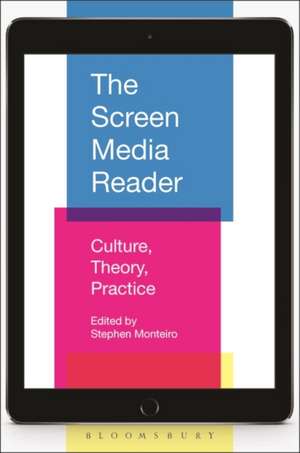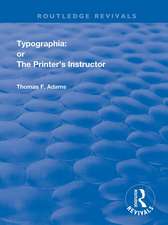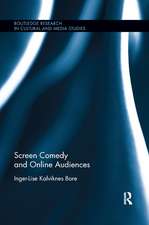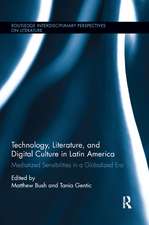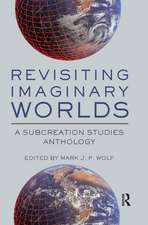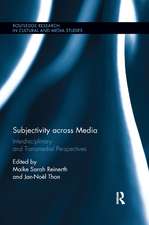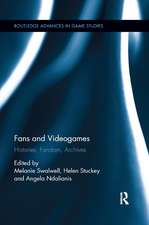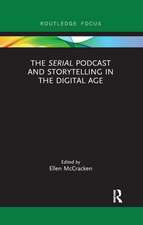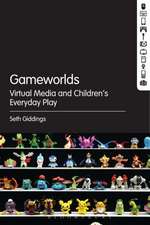The Screen Media Reader: Culture, Theory, Practice
Editat de Professor Stephen Monteiroen Limba Engleză Paperback – 11 ian 2017
| Toate formatele și edițiile | Preț | Express |
|---|---|---|
| Paperback (1) | 260.20 lei 6-8 săpt. | |
| Bloomsbury Publishing – 11 ian 2017 | 260.20 lei 6-8 săpt. | |
| Hardback (1) | 840.00 lei 6-8 săpt. | |
| Bloomsbury Publishing – 11 ian 2017 | 840.00 lei 6-8 săpt. |
Preț: 260.20 lei
Preț vechi: 292.69 lei
-11% Nou
Puncte Express: 390
Preț estimativ în valută:
49.79€ • 53.24$ • 41.51£
49.79€ • 53.24$ • 41.51£
Carte tipărită la comandă
Livrare economică 18 aprilie-02 mai
Preluare comenzi: 021 569.72.76
Specificații
ISBN-13: 9781501311703
ISBN-10: 1501311700
Pagini: 488
Ilustrații: 30 bw illus.
Dimensiuni: 156 x 235 x 30 mm
Greutate: 0.82 kg
Editura: Bloomsbury Publishing
Colecția Bloomsbury Academic
Locul publicării:New York, United States
ISBN-10: 1501311700
Pagini: 488
Ilustrații: 30 bw illus.
Dimensiuni: 156 x 235 x 30 mm
Greutate: 0.82 kg
Editura: Bloomsbury Publishing
Colecția Bloomsbury Academic
Locul publicării:New York, United States
Caracteristici
Provides students and scholars the essential documents and most important critical writings on the form, use, and function of the screen
Notă biografică
Stephen Monteiro is Assistant Professor of Communication Studies at Concordia University, Canada. He is the author of Screen Presence: Cinema Culture and the Art of Warhol, Rauschenberg, Hatoum, and Gordon (2016).
Cuprins
PrefaceAcknowledgementsPermissionsEditor's NoteIntroduction: Reflecting on the Screen Section One: Screens and Their Histories Introduction to Section One 1.1 Screen Identities Charles R. Acland (Concordia University, Canada), "The Crack in the Electric Window" Francesco Casetti (Yale University, USA), "What Is a Screen Nowadays?" Sean Cubitt (Goldsmiths, University of London, UK), "Current Screens" Anne Friedberg (University of Southern California, USA), "The Multiple" William Henry Fox Talbot (Inventor of the calotype process, UK), "The Magic Mirror" 1.2 Evolution and Revolution Plato, from The Republic Erkki Huhtamo (UCLA, USA), "Screenology; or, Media Archaeology of the Screen" Lev Manovich (CUNY, USA), "A Screen's Genealogy" Edmond Couchot (Digital Artist and Art Theoretician, France), "The Ordered Mosaic, or The Screen Overtaken by Computation" Uta Caspary (Art Historian/Architecture Critic, Germany), "Digital Media as Ornament in Contemporary Architecture Facades: Its Historical Dimension" Section Two: Images and Frames Introduction to Section Two 2.1 The Production of Images Louis-Jacques-Mandé Daguerre ('Father of Photography', France), "Description of the Process of Painting and Lighting in...Pictures of the Diorama" Lara Baladi (MIT, USA), "When Seeing is Belonging: The Photography of Tahrir" Ron Burnett (Emily Carr University of Art + Design, Canada), "Building New Worlds" Brad Chisholm (St. Cloud University, USA), "On-Screen Screens" Sarah Atkinson (King's College London, UK), "Mobile Cinema" Marcel Proust, from Swann's Way 2.2 Terms of Display Giambattista della Porta, from Natural Magick: in XX Bookes Frederick Kiesler (Architect, Ukraine), Building a Cinema Theatre Jean-Louis Baudry, "Ideological Effects of the Basic Cinematographic Apparatus" Harper Cossar (Emory College, USA), "The Shape of New Media: Screen Space, Aspect Ratios, and Digitextuality" Stephen Monteiro (The American University in Paris, France), "Fit to Frame: Image and Edge in Contemporary Interfaces" Mitchell Whitelaw (University of Canberra, Australia), "After the Screen: Array Aesthetics and Transmateriality" Section Three: Environments and Interactions Introduction to Section Three 3.1 Moments of Interface O. Winter, "The Cinematograph" Paul Frosh (The Hebrew University of Jerusalem, Israel), "The Face of Television" Douglas Engelbart, from Augmenting Human Intellect: A Conceptual Framework Heidi Rae Cooley (University of South Carolina, USA), "It's all about the Fit: The Hand, the Mobile Screenic Device and Tactile Vision" Alexandra Schneider (Johannes Gutenberg-Universität Mainz, Germany), "The iPhone as an Object of Knowledge" Virginie Sonet (Université Paris II - Panthéon-Assas, France), "The Smartphone Screen in All Its States" Amy Herzog (Queens College, CUNY, USA), "In the Flesh: Space and Embodiment in the Pornographic Peep Show Arcade" 3.2 Systems and Networks Haidee Wasson (Concordia University, Canada), "The Other Small Screen: Moving Images at New York's World Fair, 1939" Anna McCarthy (New York University, USA), "From Screen to Site: Television's Material Culture, and Its Place" Onookome Okome (University of Alberta, Canada), "Nollywood: Spectatorship, Audience and the Sites of Consumption" Stan VanDerBeek (Experimental Filmmaker, USA), "'Culture: Intercom' and Expanded Cinema: A Proposal and Manifesto" Robert Edgar, "The Aesthetics of the Arena: Live and Recorded" Nanna Verhoeff (Utrecht University, The Netherlands), "Performative Cartography"Further ReadingList of ContributorsIndex
Recenzii
The volume's multidisciplinary approach provides a comprehensive range of insights into the screen's social, historical, and cultural significance.
This volume represents a timely, capacious, and essential accounting of screens as media-a thorough thinking-through of screens not only as holders of images but as material sites of transmission, communication, and the production of knowledge. The book's cross-media and transhistorical approach brilliantly reveals new ways to conceive of screen studies' increasingly central place in humanities scholarship.
Far more than just an anthology, The Screen Media Reader is perhaps the most comprehensive response yet to the multiplicity and ambiguity of the contemporary screen, responding to its multifarious nature by juxtaposing diverse writings about it - from Plato, through Daguerre, to Manovich and Friedberg. By bringing together the most exciting writing in this field and contextualising it with clear, section-by-section introductions, the book offers a unique insight into the screen's fast-evolving nature and how leading thinkers have responded to it. For anyone interested in how screens function and how we engage with them, The Screen Media should be the first book to turn to.
A stimulating and imaginative compilation of essays which should excite any student.
This volume represents a timely, capacious, and essential accounting of screens as media-a thorough thinking-through of screens not only as holders of images but as material sites of transmission, communication, and the production of knowledge. The book's cross-media and transhistorical approach brilliantly reveals new ways to conceive of screen studies' increasingly central place in humanities scholarship.
Far more than just an anthology, The Screen Media Reader is perhaps the most comprehensive response yet to the multiplicity and ambiguity of the contemporary screen, responding to its multifarious nature by juxtaposing diverse writings about it - from Plato, through Daguerre, to Manovich and Friedberg. By bringing together the most exciting writing in this field and contextualising it with clear, section-by-section introductions, the book offers a unique insight into the screen's fast-evolving nature and how leading thinkers have responded to it. For anyone interested in how screens function and how we engage with them, The Screen Media should be the first book to turn to.
A stimulating and imaginative compilation of essays which should excite any student.
